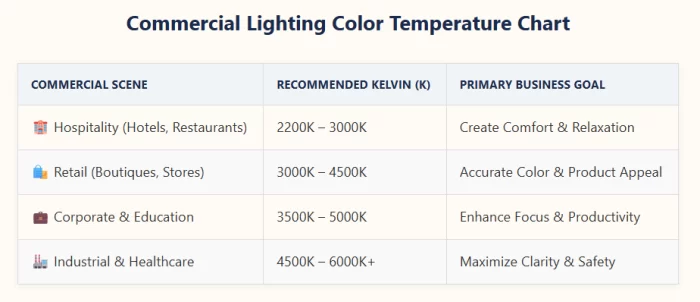Color Temperature: Your B2B Guide to Commercial Lighting
As a lighting wholesaler or purchasing manager, you are an expert. Your clients depend on you to understand complex lighting specifications. While lumens and wattage are standard, however, the conversation that builds true trust is about color temperature.
This knowledge helps you transform a client’s space, boost their product sales, and improve workplace productivity. This guide is here to help. We will explain color temperature and make the Kelvin scale a practical sales tool. By understanding the details of this topic, you become more than a supplier—you become a key lighting consultant, building client loyalty and driving business growth.
📈 1. What Exactly is Light Color Temperature?
First, let’s clarify a key point: color temperature measures visual appearance, not physical heat. The term describes the “warmth” or “coolness” of a white light source. This ranges from a yellowish, warm glow to a bluish, cool light. We measure this in Kelvin (K).
Key Takeaway: A low Kelvin value means a warmer, more yellow light. In contrast, a high Kelvin value points to a cool, bluer light. Mastering this spectrum is key to giving expert advice for both office lighting and retail design.
💡2. Decoding the Kelvin Scale: A Practical Framework
Understanding the Kelvin scale is essential for giving professional advice. Here is a practical breakdown you can use as a quick-reference tool with your clients:
- 🕯️ 1000K – 2000K (Ultra Warm White): A deep, amber glow like candlelight, used for creating extremely intimate atmospheres.
- 🛋️ 2200K – 3000K (Warm White): The soft, inviting glow of traditional incandescent bulbs. This light is flattering to skin tones, creating a comfortable and welcoming feel.
- 🏢 3100K – 4500K (Neutral or Natural White): Crisp, balanced light that minimizes yellow and blue tones. It shows true colors and boosts alertness without being harsh.
- ☀️ 4600K – 6500K (Cool White / Daylight): Mimics natural daylight. This bright, blue-tinged light is highly stimulating and ideal for tasks requiring sharp focus.
- 🔬 Over 6500K (Very Cool White): An intensely bright, blue-hued light for highly specialized industrial or clinical applications where maximum contrast is essential.
🎯3. Matching Color Temperature to Business Needs
This is where your knowledge translates directly to sales. Guiding your B2B clients to the right Kelvin setting is a strategic business decision.
Hospitality: Restaurants, Hotels, and Cafes✅
- Recommended Kelvin: 2200K – 3000K
- The Business Case: Guest comfort is the top priority. The right lighting in a hotel lobby sets the tone for a guest’s entire stay. For example, warm white light encourages relaxation and social connection. It also makes food look more appetizing and creates a welcoming mood that increases dwell time and customer satisfaction.
- [Explore our Warm White (2200K-3000K) Hospitality Collection]
Retail: Boutiques, Showrooms, and Supermarkets✅
- Recommended Kelvin: 3000K – 4500K
- The Business Case: In retail, the product is king. The proper lighting in a clothing store can make fabrics look more vibrant. A neutral Kelvin rating ensures customers see products in their true colors, which builds trust and directly influences purchase decisions.
- [View our Neutral White (3000K-4500K) Retail-Ready Fixtures]
Offices & Educational Facilities: Workstations and Classrooms✅
- Recommended Kelvin: 3500K – 5000K
- The Business Case: This is all about performance. As a key part of modern office lighting, research shows that cool white light helps reduce eye strain and improve concentration. For environments where focus is key, the correct lighting is a direct investment in productivity.
- [Browse our Cool White (3500K-5000K) Office & Commercial Lighting]
Healthcare & Industrial Settings: Clinics and Warehouses✅
- Recommended Kelvin: 4500K – 6000K
- The Business Case: Clarity and safety are the main priorities here. Using a daylight-mimicking light that meets warehouse standards is critical. This high-Kelvin light helps workers read labels and operate machinery safely. As a result, it minimizes errors and accidents.
- [See our High-Kelvin (4500K+) Industrial & Task Lighting]
📊4. Visual Guide: Color Temperature & Application Chart

Conclusion: Become a Lighting Strategist
Ultimately, a deep understanding of color temperature changes your role from a supplier to a vital lighting strategist. You are now equipped not just to sell a product, but to offer a solution that directly impacts your client’s business goals—whether it’s creating the perfect bistro mood or a hyper-productive workspace.
Ready to Take the Next Step?
- 📞 Need a Custom Solution? Have questions about a project or need a bulk quote? [Contact Our Lighting Experts for a Free Consultation]
- 🛒 Know What You Need? Browse our full catalog of commercial lighting, filterable by Kelvin rating, wattage, and more. [Contact us now for our complete commercial lighting collection.]
Frequently Asked Questions
Q1: What is light color temperature? A1: Light color temperature measures the hue of a white light source in degrees Kelvin (K). It ranges from a “warm” yellowish-white light at low Kelvin values to a “cool” bluish-white light at high Kelvin values. Importantly, it does not relate to physical heat.
Q2: What is the best color temperature for an office? A2: For most offices, we recommend a neutral to cool white light in the 3500K to 5000K range. This level of color temperature is known to enhance focus, improve productivity, and reduce eye strain.
Q3: How do I choose the right lighting for retail stores? A3: Retail stores generally benefit from neutral white light (3000K – 4500K). This range provides clean, clear illumination that showcases products in their true colors, avoiding the overly relaxing feel of warm light or the clinical feel of very cool light.
Q4: Does a higher color temperature mean the light is brighter? A4: Not always. Brightness is measured in lumens, while color is measured in Kelvin. A 3000K bulb and a 5000K bulb can have the exact same lumen output. However, the human eye often perceives cooler light (higher Kelvin) as being brighter or more intense.
